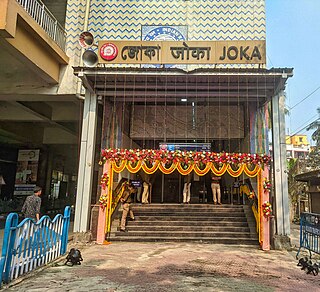
The Kolkata Metro is a rapid transit system serving the city of Kolkata and the Kolkata Metropolitan Region in West Bengal, India. Opened in 1984, it was the first operational rapid transit system in India. Besides, it's also the second busiest and fourth-longest metro network in the country. As of October 2024, it has four operational lines: the 32.13 km (19.96 mi) long Line 1, or 'Blue Line' from Dakshineswar to Kavi Subhash, 14.1 km (8.8 mi) long Line 2, or 'Green Line' from Salt Lake Sector V to Howrah Maidan, 7.75 km (4.82 mi) long Line 3, or 'Purple Line' from Joka to Majerhat and 5.4 km (3.4 mi) long Line 6, or 'Orange Line' from Kavi Subhash to Hemanta Mukhopadhyay for a total of 59.38 km (36.90 mi). Two other lines named Line 4 and Line 5 are in various phases of construction and planning. The system has a mix of underground, at-grade, and elevated stations using both broad-gauge and standard-gauge tracks. It operates on a 750 V DC Third rail system. Trains operate between 06:55 and 22:30 IST and the fares range from ₹5 to ₹50.

Kavi Subhash is the at-grade southern terminus and interchange metro station of the North-South corridor and Bypass Corridor of Kolkata Metro in Kolkata, West Bengal, India. It is named after poet Subhash Mukhopadhyay. This station was opened to public on the auspicious day of Mahalaya in 2010.

Netaji is an elevated metro station on the North-South corridor of the Blue Line of Kolkata Metro in Kolkata, West Bengal, India. This station is situated opposite to the Kudghat bus stand at Kudghat, in Tollygunge. This station is named after the freedom fighter Netaji Subhas Chandra Bose.

Esplanade is an underground interchange metro station on the North-South corridor of the Blue Line and on the East-West corridor of the Green Line of Kolkata Metro in Kolkata, West Bengal, India. This station, which is the biggest in the city, is located in the Esplanade neighbourhood of Kolkata, at the northern end of Chowringhee Road/Jawaharlal Nehru Road near New Market and the Oberoi Grand hotel. It opened in 1984 as part of what is now Kolkata Metro Line 1. The station is re-designed to be the largest station of the metro and will function as the interchange station between Line 1, Line 2 and Line 3. The Line-2 complex, built below the Line-1 complex was completed and inaugurated on 6 March 2024. The Line-2 complex is designed with world class amenities and murals that depict the culture, tradition, sports, monuments, important structures, etc in them.

Line 2 is a rapid transit metro line of the Kolkata Metro in Kolkata, West Bengal, India. It currently consists of two distinctly operational sections between Sector-V to Sealdah Metro, and Esplanade to Howrah Maidan by going underneath the Hooghly River, with an eastern extension planned for Teghoria. It will cover a distance of 22 km (14 mi) and consist of 17 stations from Teghoria (Haldiram) in the east to Howrah Maidan in the west, of which it will consist of 11 elevated and 6 underground stations, and the operational section consists of 6 elevated and 6 underground stations, with a total distance of 13.1 km (8.1 mi). It is expected to derive a very high ridership, since it will connect India's two largest commuter railway and long-distance railway terminals, Howrah and Sealdah, along with two of its largest business districts, BBD Bagh and Salt Lake Sector V. At present, more than 100,000 passengers commute through the line every day, and this figure is expected to go up to 1 million after it gets fully completed by 2035. It will also connect the industrial hub of Kolkata, i.e., Howrah and the IT hub of Kolkata, i.e., Salt Lake Sector-V. It connects Line 1 at Esplanade and will eventually connect Lines 3 and 6.

Noapara is the largest elevated metro station on the North-South corridor of the Blue Line of Kolkata Metro in Noapara, Baranagar, Kolkata, West Bengal, India. It opened on 10 July 2013.

Line 6 is a rapid transit metro line of the Kolkata Metro in Kolkata, West Bengal, India. It will connect New Garia with Netaji Subhas Chandra Bose International Airport via two major satellite towns of Kolkata metropolitan region, Salt Lake and New Town. It currently operates between Kavi Subhash and Hemanta Mukhopadhyay. This line will be one of the most important stretches of Kolkata Metro because it will connect the southern and the eastern parts of the city with Kolkata Airport. The total distance of this route will be 29.87 km (18.56 mi). It connects Line 1 at Kavi Subhash and will eventually connect Line 2 at Sector-V and Kaikhali and Line 4 at Airport.

Howrah Maidan Metro Station is a station of the Kolkata Metro Line 2 in Howrah Maidan, Howrah, India. The underground station is located near the Howrah Municipal Corporation Stadium and the Howrah Sarat Sadan. It is the terminus of Line 2 of the Kolkata Metro. The station was completed and inaugurated on 6th March 2024. Though being similar to any Line 1 underground station, it is made with world class amenities and patronage to football, the main sport of the state.

Dakshineswar is the elevated northern terminal metro station on the North-South corridor of the Blue Line of Kolkata Metro in Kolkata, West Bengal, India. The metro station adjoins the platforms of the Dakshineswar railway station where connections can be made with Indian Railways services. The station is located at the Dakshineswar area which is famous for Dakshineswar Kali Temple.

Mahakaran, is a metro station on Line 2 of Kolkata Metro, located in B.B.D. Bagh. There are many British heritage buildings near the station with the Lal Dighi adjoining it. The tracks leaving the station towards Howrah go underneath the Hooghly river through the biggest underwater metro tunnel of India. The station was completed and opened on 6 March 2024. The station, though comparing without platform screen doors, may look similar to any Line-1 underground station, but it is actually very different as it is designed with world class facilities and murals that pay tribute to the locality and Indian freedom fighters. The nearest railway station is B.B.D. Bagh railway station. Just before the tunnel enters the underwater segment, lies a ventilation shaft on the Kolkata bank of Hooghly River, which is the deepest of its kind in India, at 44 metres (144 ft) below ground level.

Howrah metro station is a metro station of Kolkata Metro Line 2 in Howrah, India. Built underneath Howrah railway station's new and old complex, the metro station allows interchanging with other zones of Indian Railways as part of the Howrah station transport hub. It is the deepest metro station in India. To the east, the station connects to Mahakaran station in Kolkata through India's biggest under-river metro tunnel beneath the Hooghly river; whilst to the west the adjacent station is Howrah Maidan.

Joka is the elevated southern terminal metro station on the North-South corridor of the Purple Line of Kolkata Metro in Kolkata, West Bengal, India. The station is located in Joka. It will be the terminal station of the Kolkata Metro Line 3 till the phase 2 of the project. In phase 3, the line will be extended 2 km more, till Diamond Park. The station was commissioned on 30 December 2022.

Majerhat metro station is an operational metro station on Line 3 of Kolkata Metro. It is the terminal station of the first phase 1 of this line and the first and only station built over an existing railway network, from Joka to Majerhat. The line was sanctioned in India's railway budget of 2010–11, but due to various hurdles, construction was delayed and missed multiple deadlines. The most notable reason for delays was the Majerhat Bridge collapse in 2018.

Behala Chowrasta is an elevated metro station on the North-South corridor of the Purple Line of Kolkata Metro in Kolkata, West Bengal, India. It is located exactly above the Behala Chowrasta intersection on Diamond Harbour Road / NH-12. It was opened in the first phase of this line. The station was commissioned on 30 December 2022.

Metro Railway, Kolkata, is the owner and operator of Kolkata Metro, the oldest metro system of India. On 29 December 2010, it became the 17th zone of the Indian Railways, operated by the Ministry of Railways.

Sakher Bazar is an elevated metro station on the North-South corridor of the Purple Line of Kolkata Metro in Kolkata, West Bengal, India. It was opened in the first phase of this line. The station was commissioned on 30 December 2022.

Jyotirindra Nandi is a metro station of Line 6 of the Kolkata Metro. The station serves Mukundapur, Santoshpur and Ajoy Nagar areas outlying the E.M. Bypass section of the city.

Kavi Sukanta is a station of Line 6 of the Kolkata Metro in Kalikapur, a southern neighbourhood of Kolkata, India, serving the areas of Kalikapur, Haltu, Prince Anwar Shah Road and Nandi Bagan. The station is named in honour of the revolutionary Bengali poet Sukanta Bhattacharya.

Hemanta Mukhopadhyay is a Metro station of Line 6 of the Kolkata Metro at Ruby Crossing, serving the areas of E.M. Bypass, Kasba and Anandapur. The station is named in honour of the Indian Bengali playback singer Hemanta Mukhopadhyay.

Beleghata, is a station of Line 6 of the Kolkata Metro located in Beleghata at Biswa Bangla Sarani, Dhapa of Kolkata, West Bengal, India, serving Beleghata and Metropolitan areas. The station is elevated beside the Eastern Metropolitan Bypass.






















